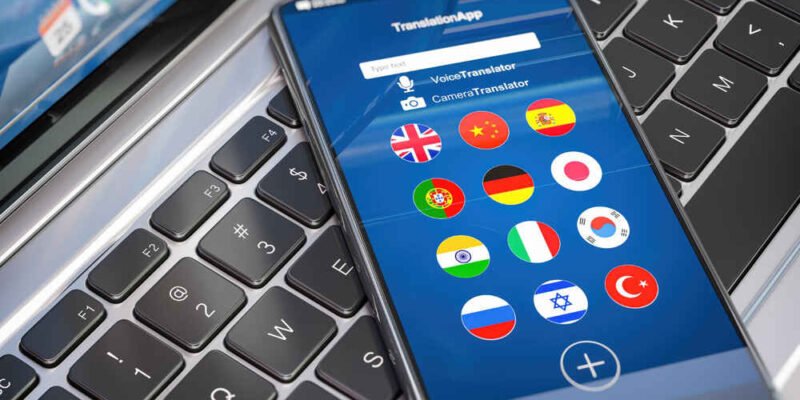Introduction
In an increasingly interconnected world, the need for seamless communication across languages has never been more vital. Language barriers have long been a hurdle in global collaboration, understanding, and commerce. However, with the advent of AI-driven technologies, these barriers are gradually dissolving. One such innovation is the AI PDF Translator, a tool designed to break down language barriers and foster global communication. This article delves into the intricacies of AI PDF Translators, exploring their functionality, importance, and the profound impact they have on our world.
What Is AI PDF Translator?
AI PDF Translator is an advanced tool that leverages artificial intelligence to translate PDF documents from one language to another. Unlike traditional translation methods, which often involve manual input and considerable time, AI PDF Translators offer a quick and efficient solution. These tools use sophisticated algorithms to understand the context, nuances, and specific terminology within a document, providing translations that are not only accurate but also contextually appropriate.
By using natural language processing (NLP) and machine learning, AI PDF Translators can interpret complex language patterns, idiomatic expressions, and industry-specific jargon. This makes them indispensable in a variety of fields, from academic research and legal documentation to global business communications. As a result, they play a crucial role in enabling effective cross-cultural dialogue and ensuring that language is no longer a barrier to global collaboration.
How Does AI PDF Translator Work?
The workings of an AI PDF Translator are a marvel of modern technology, combining multiple layers of AI-driven processes to deliver seamless translations. This section will explore how these translators operate, providing insights into the underlying technologies that make them so effective.
Natural Language Processing (NLP)
Natural Language Processing (NLP) is the cornerstone of AI PDF Translators. This technology enables the tool to understand and interpret human language in a way that is both accurate and contextually relevant. NLP breaks down sentences, recognizes syntax, and deciphers meaning, allowing the AI to grasp the nuances of the source text.
Through NLP, the AI PDF Translator can handle complex linguistic structures, ensuring that the translated text retains the original meaning and tone. This process is particularly important for documents that contain technical terms, idioms, or culturally specific references.
Machine Learning Algorithms
Machine Learning (ML) algorithms are the engines that drive continuous improvement in AI PDF Translators. These algorithms allow the system to learn from vast amounts of data, improving its translation accuracy over time. By analyzing millions of translated documents, the AI becomes better at recognizing patterns and predicting the most accurate translations.
Machine learning also enables the translator to adapt to different writing styles and subject matters, ensuring that the translation is not only accurate but also stylistically appropriate. This adaptability is crucial for translating documents across diverse fields such as law, medicine, or technology.
Optical Character Recognition (OCR)
Optical Character Recognition (OCR) plays a critical role in AI PDF Translators, especially when dealing with scanned documents or PDFs that contain images of text. OCR technology scans the document, identifies characters, and converts them into machine-readable text that can be processed by the AI.
With OCR, even non-digital, handwritten, or image-based PDFs can be accurately translated, expanding the capabilities of the AI PDF Translator. This feature is particularly valuable for translating historical documents, contracts, or any other document that exists primarily in a physical format.
Why Is AI PDF Translator Important?
The importance of AI PDF Translators lies in their ability to bridge linguistic gaps in a way that is both efficient and scalable. In today’s globalized environment, businesses, academics, and governments alike require quick and reliable translations of critical documents. The traditional methods of translation, often slow and costly, are no longer sufficient to meet these demands.
Speed and Efficiency
AI PDF Translators significantly reduce the time needed to translate documents, allowing for faster decision-making and communication.
Cost-Effective
By automating the translation process, organizations can save on the costs associated with hiring human translators for large volumes of work.
Accuracy and Consistency
The use of AI ensures that translations are consistent and free from human errors, which is particularly important in technical and legal documents.
Global Reach
AI PDF Translators enable organizations to communicate effectively across languages, expanding their reach in international markets.
Key Features of AI PDF Translator
The effectiveness of an AI PDF Translator is determined by the range of features it offers. These features are designed to enhance the translation process, ensuring that the output is not only accurate but also user-friendly and adaptable to different needs. In conjunction with the AI PDF Translator, tools like the AI PDF Editor allow users to not only translate but also modify the content of PDFs, making these AI-powered applications even more versatile.
Multilingual Support
One of the most significant features of AI PDF Translators is their ability to support multiple languages. This feature allows users to translate documents between a vast array of languages, making the tool versatile and applicable in many different contexts.
- Wide Language Range: From common languages like English, Spanish, and Mandarin to less commonly spoken languages, AI PDF Translators cover a broad spectrum.
- Cultural Sensitivity: The AI is programmed to understand cultural nuances, ensuring that translations are not only accurate but also appropriate for the target audience.
Customizable Dictionaries
Customizable dictionaries are another key feature, allowing users to input specific terminology or jargon that is unique to their industry. This ensures that specialized terms are translated correctly, maintaining the integrity of the document.
- Industry-Specific Terms: Users can customize the translator with terms relevant to their field, such as legal, medical, or technical jargon.
- Consistency Across Documents: By using a customizable dictionary, the AI ensures that terminology is consistent across multiple translations.
User-Friendly Interface
A user-friendly interface is crucial for ensuring that the AI PDF Translator is accessible to a wide range of users, from tech-savvy professionals to those less familiar with technology.
- Intuitive Design: The interface is designed to be easy to navigate, with clear instructions and accessible features.
- Batch Processing: Users can translate multiple documents at once, streamlining the process and saving time.
Benefits of Using AI PDF Translator
Using an AI PDF Translator offers a myriad of benefits that extend beyond simple translation. These tools not only enhance communication but also streamline operations and reduce costs.
Enhanced Communication
By breaking down language barriers, AI PDF Translators enable clearer and more effective communication between individuals and organizations across the globe.
Operational Efficiency
The speed and accuracy of AI-driven translations allow businesses to operate more efficiently, reducing delays and ensuring that projects stay on track.
Cost Reduction
Automating the translation process can significantly lower costs, particularly for organizations that require frequent translations of large volumes of text.
Improved Accessibility
AI PDF Translators make information accessible to a wider audience, promoting inclusivity and ensuring that language is not a barrier to knowledge.
Who Can Benefit from AI PDF Translator?
AI PDF Translators are versatile tools that can be beneficial to a wide range of users, from multinational corporations to individual professionals.
Businesses
Businesses operating in international markets stand to gain significantly from AI PDF Translators. These tools enable companies to translate contracts, marketing materials, and other critical documents quickly and accurately.
For businesses, the ability to communicate effectively across languages is crucial for expanding into new markets and building relationships with international partners. AI PDF Translators ensure that language is not an obstacle to growth, helping businesses to scale their operations globally.
Academic Institutions
Academic institutions, especially those involved in international research, can benefit from AI PDF Translators. These tools allow for the translation of academic papers, research findings, and other scholarly materials, facilitating collaboration between researchers from different linguistic backgrounds.
For academics, the ability to access and share knowledge across languages is vital for advancing research and fostering global academic communities. AI PDF Translators help break down language barriers in academia, promoting the free exchange of ideas.
Legal Professionals
Legal professionals who deal with international clients or cases involving foreign documents can also benefit from AI PDF Translators. These tools ensure that legal documents are translated accurately, preserving the intent and legal validity of the original text.
For lawyers and legal firms, accurate translations are essential for maintaining the integrity of legal proceedings. AI PDF Translators provide a reliable solution for translating legal texts, ensuring that language is not a barrier to justice.
Challenges in AI PDF Translation
Despite their many advantages, AI PDF Translators are not without their challenges. These issues must be addressed to further enhance the effectiveness of these tools. Additionally, similar challenges are faced by tools like the AI PDF Summarizer, which must accurately condense information while preserving the meaning and context. The same complexities that arise in translation, such as contextual understanding and cultural nuances, also impact these summarization tools, making it crucial to continue refining AI technologies to better handle these challenges.
- Complex Linguistic Structures: Some languages have complex grammatical structures that are difficult for AI to translate accurately.
- Contextual Understanding: AI may struggle with understanding context in certain documents, leading to translations that are technically correct but contextually inappropriate.
- Cultural Nuances: AI can sometimes miss subtle cultural nuances, resulting in translations that are technically accurate but culturally insensitive.
- Data Privacy Concerns: Translating sensitive documents using AI tools can raise concerns about data privacy and the security of confidential information.
Future of AI PDF Translators
The future of AI PDF Translators is promising, with ongoing advancements in AI and machine learning set to enhance their capabilities even further. As AI technology continues to evolve, we can expect these translators to become even more accurate, faster, and capable of handling increasingly complex documents.
In the future, AI PDF Translators may incorporate more advanced features, such as real-time translation, deeper contextual understanding, and greater cultural sensitivity. These developments will not only improve the quality of translations but also make these tools even more indispensable in a globalized world.
Moreover, as data privacy concerns grow, future AI PDF Translators will likely place a greater emphasis on security, ensuring that sensitive information remains protected during the translation process.
Conclusion
AI PDF Translators represent a significant step forward in overcoming language barriers and enabling global communication. By leveraging advanced AI technologies, these tools provide accurate, efficient, and cost-effective translations that are essential for businesses, academics, legal professionals, and more. As AI continues to advance, the potential for AI PDF Translators to revolutionize the way we communicate across languages is immense, making them a crucial component of our increasingly interconnected world.
Also Read Interesting articles at Disboard.co.uk













